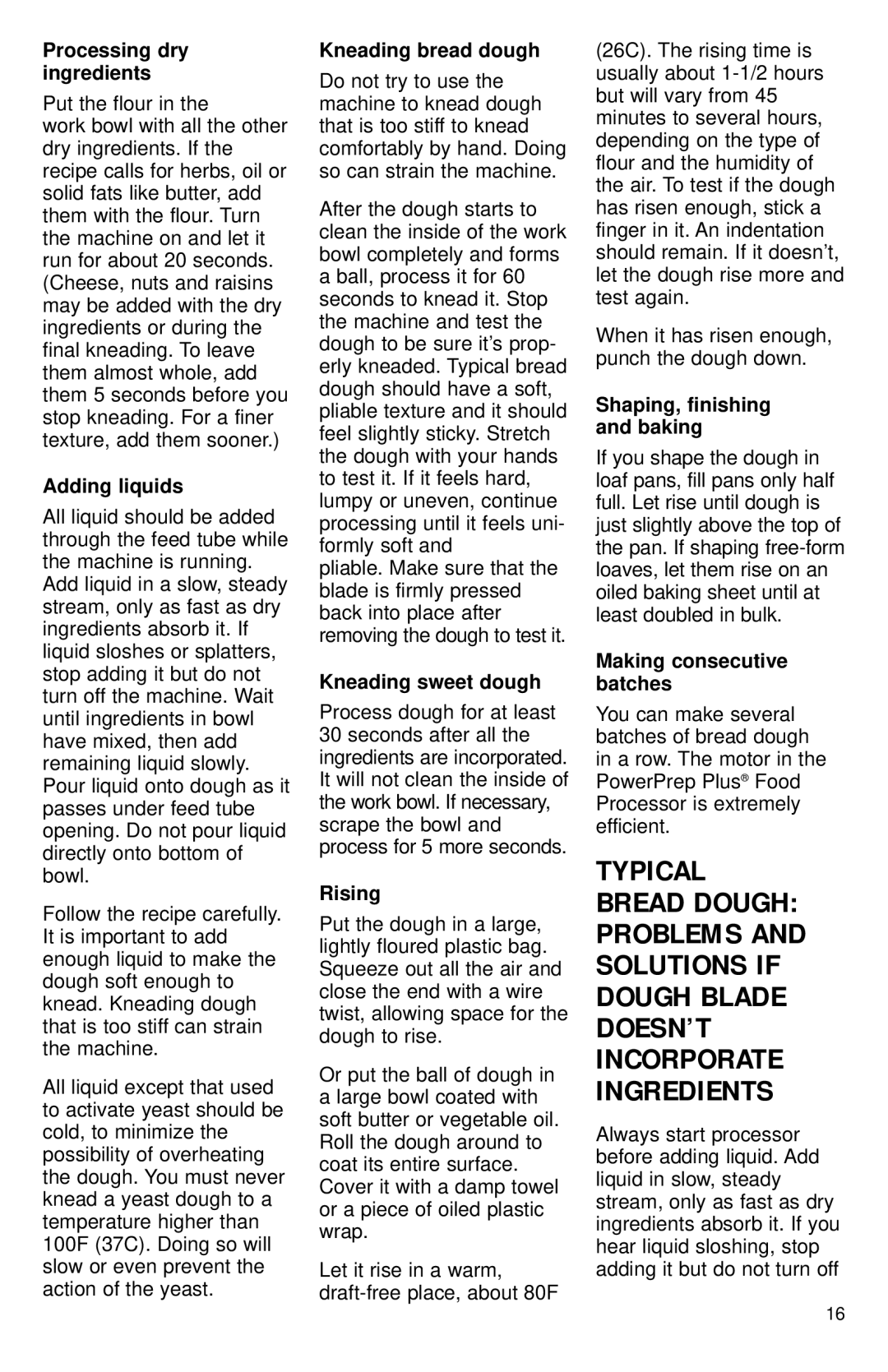Processing dry ingredients
Put the flour in the
work bowl with all the other dry ingredients. If the recipe calls for herbs, oil or solid fats like butter, add them with the flour. Turn the machine on and let it run for about 20 seconds. (Cheese, nuts and raisins may be added with the dry ingredients or during the final kneading. To leave them almost whole, add them 5 seconds before you stop kneading. For a finer texture, add them sooner.)
Adding liquids
All liquid should be added through the feed tube while the machine is running. Add liquid in a slow, steady stream, only as fast as dry ingredients absorb it. If liquid sloshes or splatters, stop adding it but do not turn off the machine. Wait until ingredients in bowl have mixed, then add remaining liquid slowly. Pour liquid onto dough as it passes under feed tube opening. Do not pour liquid directly onto bottom of bowl.
Follow the recipe carefully. It is important to add enough liquid to make the dough soft enough to knead. Kneading dough that is too stiff can strain the machine.
All liquid except that used to activate yeast should be cold, to minimize the possibility of overheating the dough. You must never knead a yeast dough to a temperature higher than 100F (37C). Doing so will slow or even prevent the action of the yeast.
Kneading bread dough
Do not try to use the machine to knead dough that is too stiff to knead comfortably by hand. Doing so can strain the machine.
After the dough starts to clean the inside of the work bowl completely and forms a ball, process it for 60 seconds to knead it. Stop the machine and test the dough to be sure it’s prop- erly kneaded. Typical bread dough should have a soft, pliable texture and it should feel slightly sticky. Stretch the dough with your hands to test it. If it feels hard, lumpy or uneven, continue processing until it feels uni- formly soft and
pliable. Make sure that the blade is firmly pressed back into place after removing the dough to test it.
Kneading sweet dough
Process dough for at least 30 seconds after all the ingredients are incorporated. It will not clean the inside of the work bowl. If necessary, scrape the bowl and process for 5 more seconds.
Rising
Put the dough in a large, lightly floured plastic bag. Squeeze out all the air and close the end with a wire twist, allowing space for the dough to rise.
Or put the ball of dough in a large bowl coated with soft butter or vegetable oil. Roll the dough around to coat its entire surface. Cover it with a damp towel or a piece of oiled plastic wrap.
Let it rise in a warm,
(26C). The rising time is usually about
When it has risen enough, punch the dough down.
Shaping, finishing and baking
If you shape the dough in loaf pans, fill pans only half full. Let rise until dough is just slightly above the top of the pan. If shaping
Making consecutive batches
You can make several batches of bread dough in a row. The motor in the PowerPrep Plus® Food Processor is extremely efficient.
TYPICAL BREAD DOUGH: PROBLEMS AND SOLUTIONS IF DOUGH BLADE DOESN’T INCORPORATE INGREDIENTS
Always start processor before adding liquid. Add liquid in slow, steady stream, only as fast as dry ingredients absorb it. If you hear liquid sloshing, stop adding it but do not turn off
16
